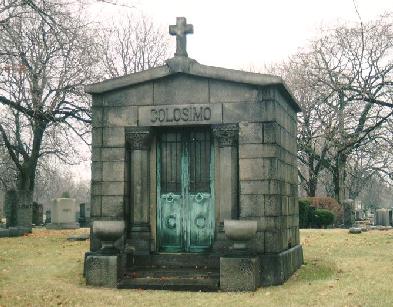
Giacomo Colosimo emigrated from Calabria, Italy, arriving in Chicago in the 1890s. Giacomo, or Jim, was at first a pickpocket, a pimp, and a Black Hand extortionist, while working the occasional honest job as a street sweeper. When he became a foreman, he was noticed by "Hinky Dink" Kenna and "Bathhouse" John Coughlin, First Ward aldermen. He worked for them as a Democratic precinct captain and thug, collecting tribute for the corrupt aldermen.
In 1902 "Big Jim" married Victoria Moresco, a madam and much older than Colosimo. They opened a second whorehouse and soon gained control of several others. Big Jim organized a white-slavery ring, where young girls would be lured to the city with promises of good jobs, imprisoned, raped, and, their spirits broken, sold to other whorehouse keepers. Within a few years Big Jim owned 200 brothels, and was also involved in gambling, extortion, and numerous other criminal activities.
In 1909 Colosimo himself was threatened by Black Hand extortionists. Needing help in dealing with this threat, he sent for his nephew in Brooklyn, Johnny Torrio. Three men who had threatened Colosimo were soon found dead.
In 1910 Big Jim opened his restaurant, Colosimo's Cafe, at 2126 South Wabash. With the closing of the Everleigh club, the south side Levee was fading away as a vice district. At Torrio's urging, Colosimo opened a brothel in the small town of Burnham. Having gained this foothold, they took over more and more of the town, turning it into a hotbed of degeneracy. Torrio built a brothel and casino at 2222 S. Wabash, just a block from Colosimo's Cafe. Because of its address, it was called the Four Deuces. In 1919, Torrio invited his trusted Brooklyn lieutenant, Alphonse Capone, to work as bartender and bouncer at the Four Deuces.
Big Jim had, in Torrio's eyes, gotten lazy and complacent. He showed no interest in new ventures. But Prohibition had just gone into effect in January of 1920, and Torrio wanted to seize the opportunity to move into bootlegging. Meanwhile, Colosimo had deserted Victoria in order to marry nineteen-year-old singer Dale Winter.
On May 11, 1920, one week after marrying Dale, Torrio phoned Colosimo and asked him to take delivery of two truckloads of whisky at the Cafe. Big Jim was driven to the cafe, walked through the dining room and into his office. He asked his secretary and chef, who were in the office, if anyone had called, and then walked out, toward the entrance vestibule. The chef and secretary then heard two shots, and upon investigation, found Colosimo dead on the tiled floor of the vestibule, shot behind the right ear.
Torrio and Capone were questioned by police, but were able to provide a convincing alibi. "Big Jim and me were like brothers" said Torrio. Also questioned and released was New Yorker Frankie Yale. Soon afterwards, a witness described the man he had seen enter the cafe shortly before Big Jim's murder - a description that fitted Yale. However, he failed to identify Yale when confronted with him in person. Although no one was ever convicted of Colosimo's murder, it is generally believed that Yale was the killer, hired by Torrio.
Archbishop George Mundelein forbade Colosimo's burial in a Catholic cemetery: "any gangster who...is looked upon as a 'public' sinnter... is to be refused Christian burial". The church accused Colosimo of only one sin - not murder, theft, or rape, but simply having divorced his wife to marry Dale Winter. In spite of the Archbishop's edict, Colosimo's old friend Bathhouse John Coughlin knelt by the casket and recited prayers.
As with many mob funerals, Colosimo's was enormous. Expensive floral tributes surrounded a bronze coffin. The fifty-three pallbearers included judges and Congressmen. One thousand First Ward Democrats marched in the funeral procession to Oak Woods, accompanied by two brass bands.
In the years to come, an unknown person would occasionally leave a mason jar filled with flowers on the steps of Big Jim Colosimo's mausoleum.



